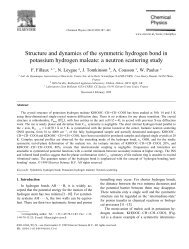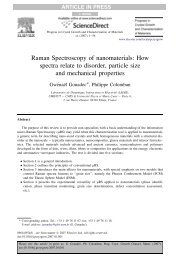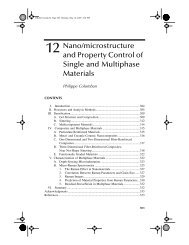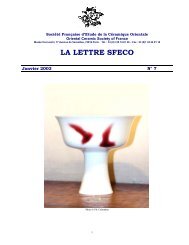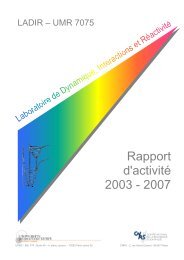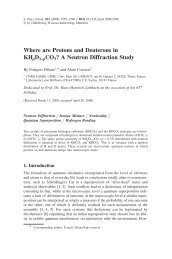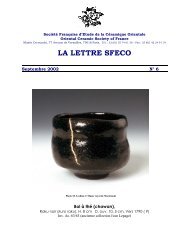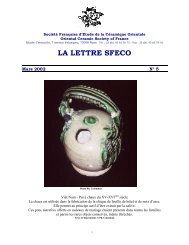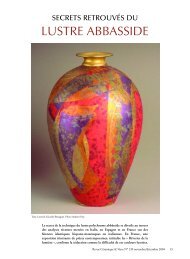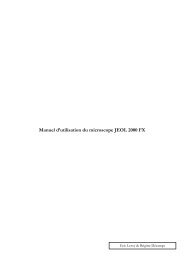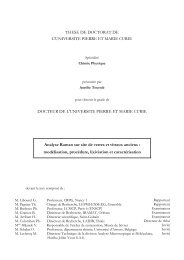RAMAN µ-SPECTROMETRY, A UNIQUE TOOL FOR ON-SITE ...
RAMAN µ-SPECTROMETRY, A UNIQUE TOOL FOR ON-SITE ...
RAMAN µ-SPECTROMETRY, A UNIQUE TOOL FOR ON-SITE ...
Create successful ePaper yourself
Turn your PDF publications into a flip-book with our unique Google optimized e-Paper software.
OO8.3.10<br />
- i) Crystalline phases within the body are identified. It is easily obtained by comparison with<br />
Raman spectra databases ([11,12, 24-26] and refs therein). Examples are given for typical hardpaste<br />
(mullite-based from Meissen, Saxony) and soft-paste porcelains (calcium<br />
silicate/phosphate-based, from St-Cloud (Fig. 1b) and Chantilly, France). The information is<br />
very similar to that obtained from x-ray diffraction, but Raman spectrometry uses the visible<br />
light and can be performed on-site [10,13]. Furthermore, small size (micrometer-to-nanometer)<br />
precipitates, within the glaze, are easily detected by Raman scattering, whereas they are hardly<br />
detected by x-ray diffraction. Figures 1b and 4a compare spectra recorded on Saint-Cloud and<br />
Sèvres with Medici porcelain glazes. Combined semi-quantitative identification of crystalline<br />
phases such as phosphates, wollastonites, cassiterite and others in body and glazes allows the<br />
identification of artifact production sites [27].<br />
- ii) Structure and composition of glassy silicates. The Raman intensity of Si-O bending and<br />
stretching envelopes vary with composition. Their different components inform us of the<br />
connectivity of the SiO 4 polymeric units and, thus, of the glass composition, nanostructure and<br />
processing temperature [1,7 and references therein]. A clear differentiation is possible through<br />
the relative intensities of the components of the Si-O stretching and bending modes at about<br />
1000 and 500 cm -1 respectively (Fig. 5). Because the SiO 4 tetrahedron is a very well defined<br />
vibrational and structural entity, its different configurations have specific vibrational fingerprints.<br />
From the literature [e.g. 1,7 and refs therein] the different spectral components of the Si-O bond<br />
stretching envelope were assigned to the tetrahedron vibrations with zero (Q 0 or isolated SiO 4 ),<br />
one (Q 1 or dumbbell -SiO 3 ), two (Q 2 or =SiO 2 ), and three (Q 3 or ≡SiO) bridging oxygen atoms<br />
per tetrahedral group. Q 4 corresponds to fully polymerized tetrahedron, as in pure silica.<br />
Decomposition of the Si-O bending and stretching massifs is illustrated with the example of<br />
Medici glaze in Figure 4.<br />
The plot of all component areas as a function of their center of gravity gives a representative<br />
view of the intrinsic homogeneity of the ceramic production (Figure 6) and can be used to<br />
identify artifacts made with different processes. Note that the variability of the Q 0 component<br />
(isolated SiO 4 ) is always very small whatever the artifact studied. The variability of Q 4<br />
component often is not significant because of its strong sensitivity to the baseline subtraction. By<br />
comparison to other fritwares studied in our laboratory, the production of Iznik ware appears<br />
very homogeneous. However, as shown in Figure 5, which compares the plots of Iznik artifacts<br />
assigned to the periods 1480 - ~1650 and > 1650 (late Iznik) ; small differences are observed for<br />
the centers of gravity. These differences, combined with those of the Q n (n = 1, 2 and 3)<br />
components allows for the classification of the different productions, as shown in Table 1.<br />
Differentiation between Medici, Iznik and Kütahya pottery glazes is straightforward from the<br />
centers of gravity but differentiation between Iznik, late Iznik and Kütayha productions requires<br />
consideration of the area ratios (Table 1).<br />
Index of polymerization, glass composition and processing<br />
Figure 5 compares different Raman signatures of glasses and glazes with various silica and<br />
fluxing oxide contents. For instance, the spectrum of silica-rich hard-paste glaze consists in a<br />
strong band at ~500 cm -1 (Si-O bending massif) and a weak bump at ~1000 cm -1 (Si-O stretching<br />
modes).



